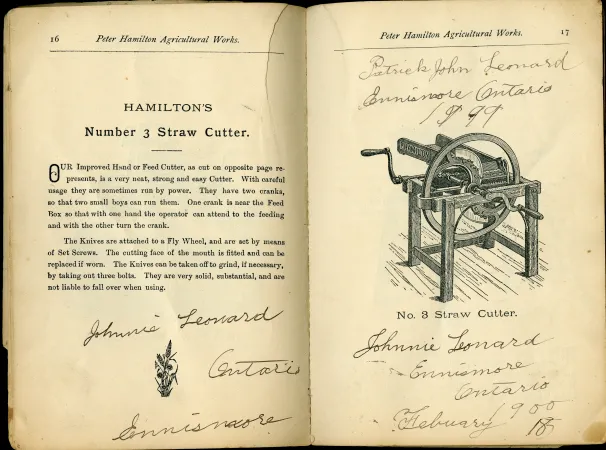Uncovering the age-old angst of love

Romantic song lyrics are not exactly what you’d expect to find in the pages of an old, agricultural catalogue. But as Ingenium staff members have learned, artifacts can be full of surprises.
In 2019, librarian Catherine Campbell was inventorying the trade literature collection recently unpacked in the new Library and Archives, located inside the Ingenium Centre in Ottawa. In the midst of her work she came across the lyrics to a love song, handwritten in pencil over the first few pages of an old catalogue dating back to 1889.
“I picked up this nondescript catalogue of agricultural implements with its torn and partially missing cover, and noticed that the back of the cover and the first couple of pages were covered in handwriting. I began to read, ‘The art of love makin is hard to unfold …’ and thought, ‘Wow! This is not what I usually find in my trade catalogues! Who wrote this?'”
The discovery prompted Campbell and archivist Adele Torrance to do some investigative work. She noticed the name “Johnnie Leonard” was signed alongside the love song. Assuming he was the one who wrote in the catalogue, and knowing the catalogue was produced in Ontario in 1889, she pulled some historical census information in order to find the Leonard family.
In the 1851 Census of Ennismore, Ontario, they found a multi-generational Leonard family living together on a farm. It appears the patriarch, Batt Leonard, emigrated from Ireland with his son, Patrick, and daughter-in-law, Ellen Leonard, who by 1851 had nine Canadian-born children. One of those children was a 12-year-old son named Martin, who, by the 1881 Census, had a nine-year-old son of his own, Patrick John. By the time the 1889 trade catalogue was produced, Patrick John or “Johnnie Leonard” would have been 17 years old.
A closer look
Next, Campbell studied the catalogue itself. Its title is quite long: “Peter Hamilton Agricultural Works, manufacturers of [Hamilton's?] light steel binder, mowers, sulky rakes, riding and walking ploughs, root pulpers, grain crushers, grain sowers, straw cutters, and all kind of agricultural implements.” Campbell confirmed that the Peter Hamilton Manufacturing Company was based in Peterborough, Ontario. James Hamilton, an immigrant from Scotland, had built a foundry in 1848 where he produced castings and agricultural equipment. In 1866, the company suffered a fire and a new two-storey brick foundry was built to replace the earlier factory that had burned to the ground.
Owner James Hamilton died in 1872, and his son Peter Hamilton became sole proprietor. He expanded the business over the years to include reapers and mowers in the line of products, and continued to offer repairs on any agricultural implement, just as his father had offered. In the introduction to the 1889 catalogue, Peter Hamilton wrote, “In addition to presenting cuts and descriptions of the best farming implements made, the catalogue contains memorandum tables to enable the farmer to make notes of important events, and keep a record of his farming and dairying operations.” Johnnie Leonard used the catalogue for more than just operational notes. The gallery below shows the song, some of Johnnie’s signatures later in the book, and perhaps a self-portrait?
A teenage love story
The last piece of the puzzle were the lyrics themselves. Campbell researched the title, “I Guess You Have All Been There,” and discovered it was written by American composer J.P. Skelly. But how did Johnnie hear the song and what did it mean to him? Was he pining after a woman named Kate, as well? Archivist Adele Torrance thought that Johnnie might have heard a recording of the song on an early wax cylinder playing on a nickel-in-the-slot phonograph. In the historical assessment Sound Recordings in Canada, curator Bryan Dewalt and historian John Vardalas explain that in the 1890s, such machines had “found [their] way into arcades, neighbourhood drugstores, local bars, and wherever people gathered socially.” However, in a few short years, mass-produced discs for Gramophone were also available. “I Guess You Have All Been There” was recorded with the Berliner, Victor, Columbia, and Edison recording companies in the late nineteenth century and early twentieth century. The first discs made in Canada were pressed by E. Berliner in 1900. Library and Archives Canada also has a good description of the early days of recorded music in Canada.
By 1900, Johnnie would have been around 28 years old and the Peter Hamilton catalogue would have been out of date, but perhaps that’s why he used it as scrap paper to record the lyrics that inspired him? A last possibility is that Johnnie had access to the sheet music for the song, like the sheet shown below from the Library of Congress’s collections, published by W.F. Shaw in 1879. This would make sense as Johnnie transcribed the numbers of the verses, information that only appears on the sheet music. Perhaps he grabbed the Peter Hamilton catalogue to copy the lyrics so he could sing along with a group of friends.
It’s fun to think of Johnnie as a love-sick teenager, recording lyrics while listening to early music recordings. This Valentine’s Day, many of us can think back to our own romantic teen angst and relate. It seems Johnnie’s favourite song is aptly named…I guess you’ve all been there.































